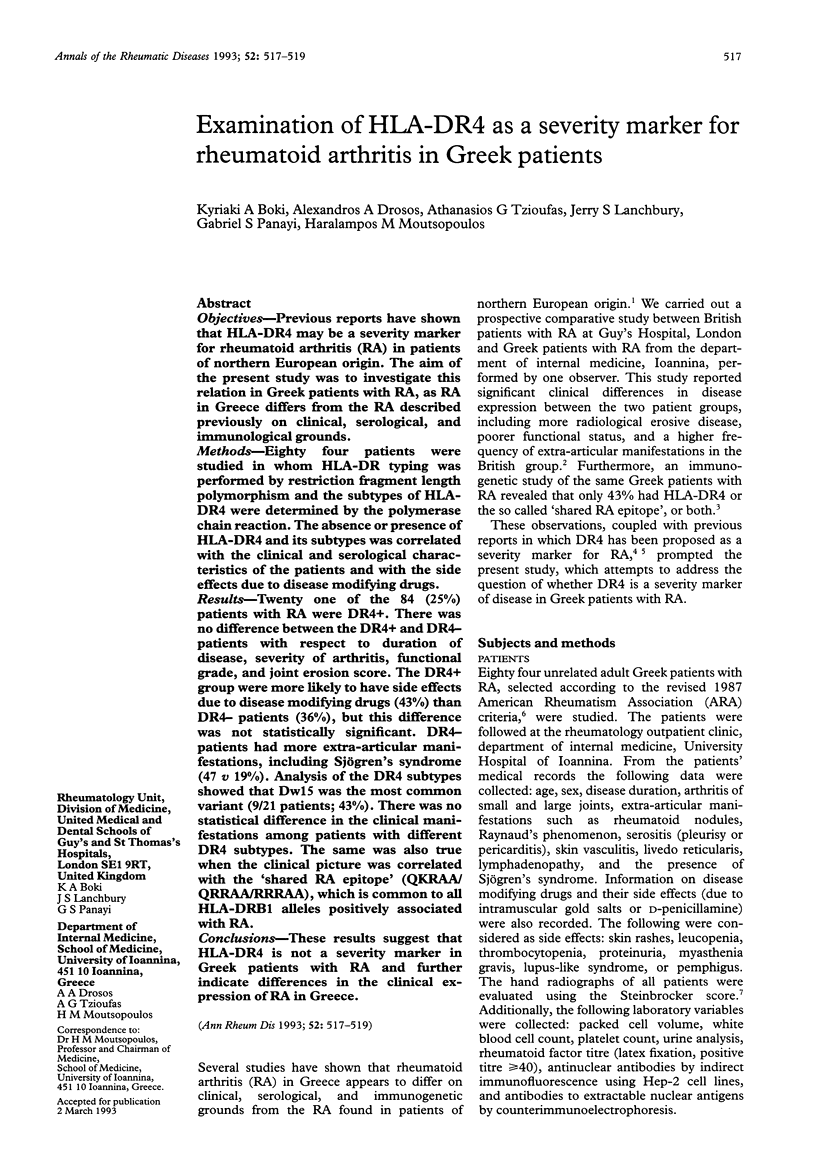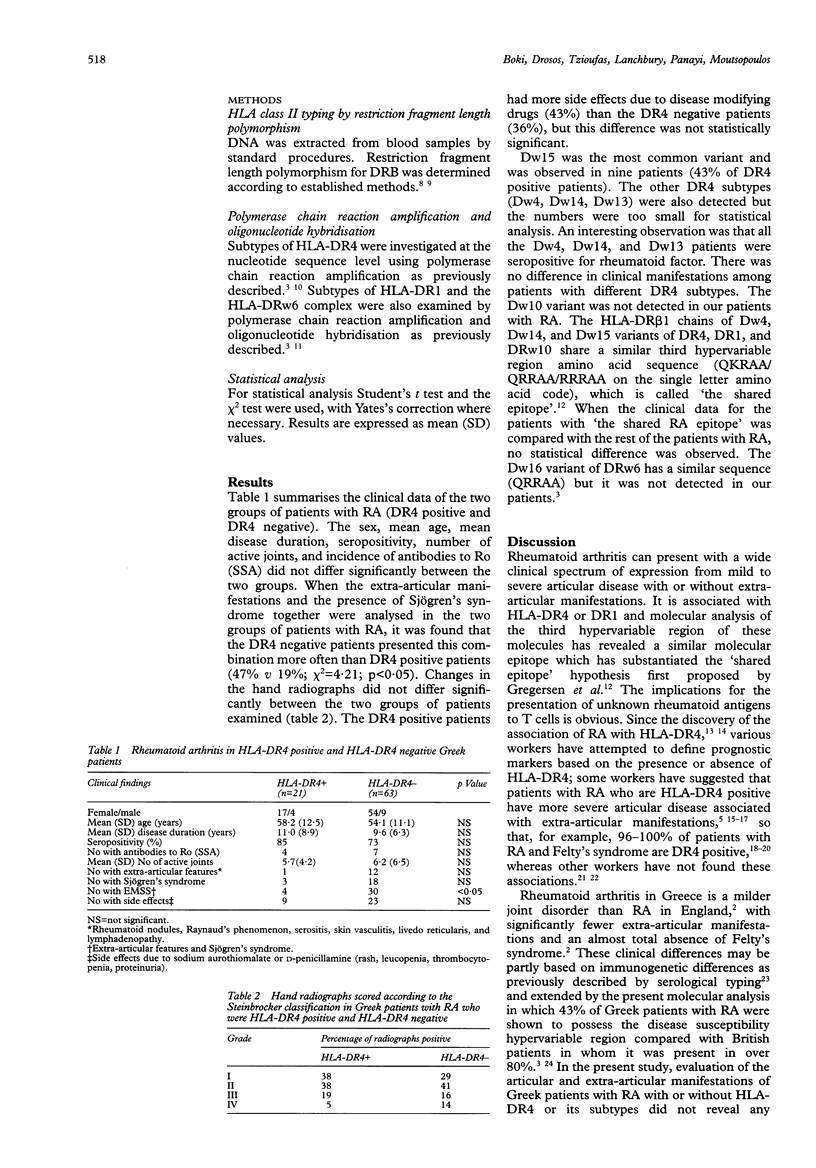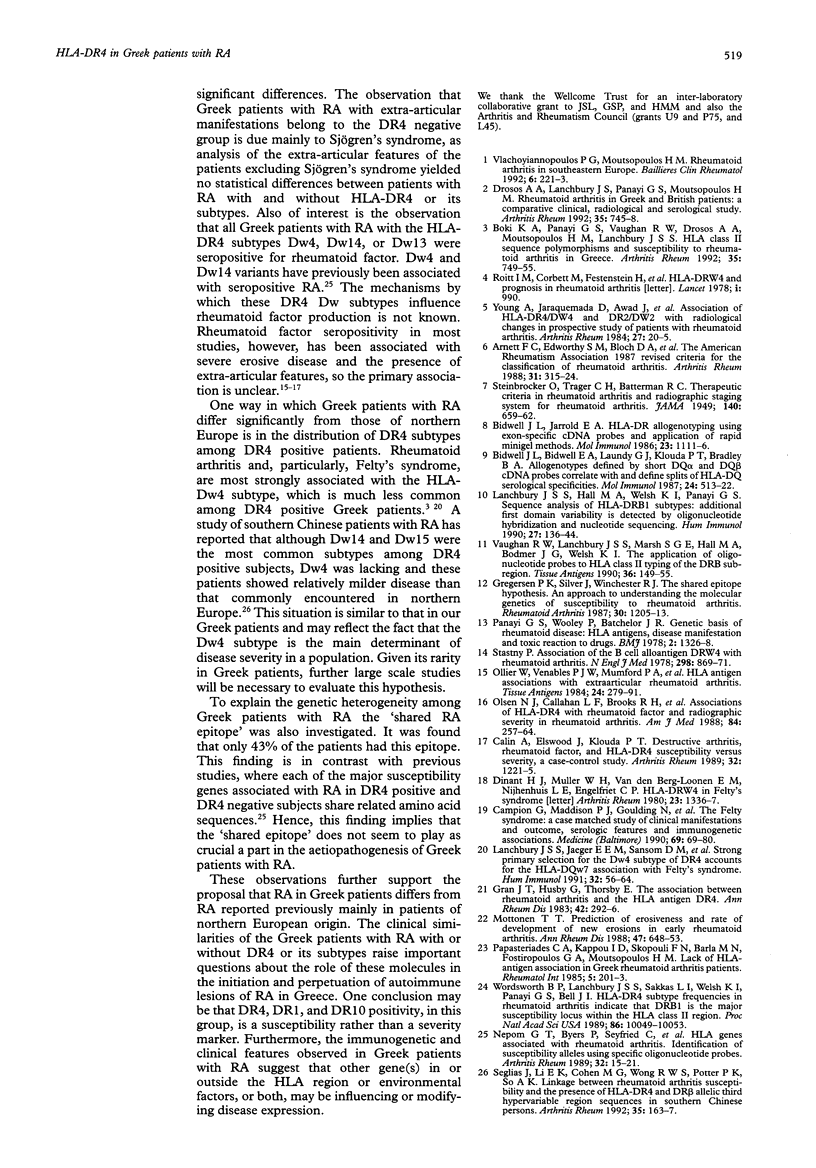Abstract
OBJECTIVES--Previous reports have shown that HLA-DR4 may be a severity marker for rheumatoid arthritis (RA) in patients of northern European origin. The aim of the present study was to investigate this relation in Greek patients with RA, as RA in Greece differs from the RA described previously on clinical, serological, and immunological grounds. METHODS--Eighty four patients were studied in whom HLA-DR typing was performed by restriction fragment length polymorphism and the subtypes of HLA-DR4 were determined by the polymerase chain reaction. The absence or presence of HLA-DR4 and its subtypes was correlated with the clinical and serological characteristics of the patients and with the side effects due to disease modifying drugs. RESULTS--Twenty one of the 84 (25%) patients with RA were DR4+. There was no difference between the DR4+ and DR4-patients with respect to duration of disease, severity of arthritis, functional grade, and joint erosion score. The DR4+ group were more likely to have side effects due to disease modifying drugs (43%) than DR4- patients (36%), but this difference was not statistically significant. DR4-patients had more extra-articular manifestations, including Sjögren's syndrome (47 v 19%). Analysis of the DR4 subtypes showed that Dw15 was the most common variant (9/21 patients; 43%). There was no statistical difference in the clinical manifestations among patients with different DR4 subtypes. The same was also true when the clinical picture was correlated with the 'shared RA epitope' (QKRAA/QRRAA/RRRAA), which is common to all HLA-DRB1 alleles positively associated with RA. CONCLUSIONS--These results suggest that HLA-DR4 is not a severity marker in Greek patients with RA and further indicate differences in the clinical expression of RA in Greece.
Full text
PDF


Selected References
These references are in PubMed. This may not be the complete list of references from this article.
- Arnett F. C., Edworthy S. M., Bloch D. A., McShane D. J., Fries J. F., Cooper N. S., Healey L. A., Kaplan S. R., Liang M. H., Luthra H. S. The American Rheumatism Association 1987 revised criteria for the classification of rheumatoid arthritis. Arthritis Rheum. 1988 Mar;31(3):315–324. doi: 10.1002/art.1780310302. [DOI] [PubMed] [Google Scholar]
- Bidwell J. L., Bidwell E. A., Laundy G. J., Klouda P. T., Bradley B. A. Allogenotypes defined by short DQ alpha and DQ beta cDNA probes correlate with and define splits of HLA-DQ serological specificities. Mol Immunol. 1987 May;24(5):513–522. doi: 10.1016/0161-5890(87)90026-5. [DOI] [PubMed] [Google Scholar]
- Bidwell J. L., Jarrold E. A. HLA-DR allogenotyping using exon-specific cDNA probes and application of rapid minigel methods. Mol Immunol. 1986 Oct;23(10):1111–1116. doi: 10.1016/0161-5890(86)90009-x. [DOI] [PubMed] [Google Scholar]
- Boki K. A., Panayi G. S., Vaughan R. W., Drosos A. A., Moutsopoulos H. M., Lanchbury J. S. HLA class II sequence polymorphisms and susceptibility to rheumatoid arthritis in Greeks. The HLA-DR beta shared-epitope hypothesis accounts for the disease in only a minority of Greek patients. Arthritis Rheum. 1992 Jul;35(7):749–755. doi: 10.1002/art.1780350706. [DOI] [PubMed] [Google Scholar]
- Calin A., Elswood J., Klouda P. T. Destructive arthritis, rheumatoid factor, and HLA-DR4. Susceptibility versus severity, a case-control study. Arthritis Rheum. 1989 Oct;32(10):1221–1225. doi: 10.1002/anr.1780321006. [DOI] [PubMed] [Google Scholar]
- Campion G., Maddison P. J., Goulding N., James I., Ahern M. J., Watt I., Sansom D. The Felty syndrome: a case-matched study of clinical manifestations and outcome, serologic features, and immunogenetic associations. Medicine (Baltimore) 1990 Mar;69(2):69–80. [PubMed] [Google Scholar]
- Dinant H. J., Hissink Muller W., van den Berg-Loonen E. M., Nijenhuis L. E., Engelfriet C. P. HLA-DRw4 in Felty's syndrome. Arthritis Rheum. 1980 Nov;23(11):1336–1336. doi: 10.1002/art.1780231126. [DOI] [PubMed] [Google Scholar]
- Drosos A. A., Lanchbury J. S., Panayi G. S., Moutsopoulos H. M. Rheumatoid arthritis in Greek and British patients. A comparative clinical, radiologic, and serologic study. Arthritis Rheum. 1992 Jul;35(7):745–748. doi: 10.1002/art.1780350705. [DOI] [PubMed] [Google Scholar]
- Gran J. T., Husby G., Thorsby E. The association between rheumatoid arthritis and the HLA antigen DR4. Ann Rheum Dis. 1983 Jun;42(3):292–296. doi: 10.1136/ard.42.3.292. [DOI] [PMC free article] [PubMed] [Google Scholar]
- Gregersen P. K., Silver J., Winchester R. J. The shared epitope hypothesis. An approach to understanding the molecular genetics of susceptibility to rheumatoid arthritis. Arthritis Rheum. 1987 Nov;30(11):1205–1213. doi: 10.1002/art.1780301102. [DOI] [PubMed] [Google Scholar]
- Lanchbury J. S., Hall M. A., Welsh K. I., Panayi G. S. Sequence analysis of HLA-DR4B1 subtypes: additional first domain variability is detected by oligonucleotide hybridization and nucleotide sequencing. Hum Immunol. 1990 Feb;27(2):136–144. doi: 10.1016/0198-8859(90)90110-b. [DOI] [PubMed] [Google Scholar]
- Lanchbury J. S., Jaeger E. E., Sansom D. M., Hall M. A., Wordsworth P., Stedeford J., Bell J. I., Panayi G. S. Strong primary selection for the Dw4 subtype of DR4 accounts for the HLA-DQw7 association with Felty's syndrome. Hum Immunol. 1991 Sep;32(1):56–64. doi: 10.1016/0198-8859(91)90117-r. [DOI] [PubMed] [Google Scholar]
- Möttönen T. T. Prediction of erosiveness and rate of development of new erosions in early rheumatoid arthritis. Ann Rheum Dis. 1988 Aug;47(8):648–653. doi: 10.1136/ard.47.8.648. [DOI] [PMC free article] [PubMed] [Google Scholar]
- Nepom G. T., Byers P., Seyfried C., Healey L. A., Wilske K. R., Stage D., Nepom B. S. HLA genes associated with rheumatoid arthritis. Identification of susceptibility alleles using specific oligonucleotide probes. Arthritis Rheum. 1989 Jan;32(1):15–21. doi: 10.1002/anr.1780320104. [DOI] [PubMed] [Google Scholar]
- Ollier W., Venables P. J., Mumford P. A., Maini R. N., Awad J., Jaraquemada D., D'Amaro J., Festenstein H. HLA antigen associations with extra-articular rheumatoid arthritis. Tissue Antigens. 1984 Nov;24(5):279–291. doi: 10.1111/j.1399-0039.1984.tb02139.x. [DOI] [PubMed] [Google Scholar]
- Olsen N. J., Callahan L. F., Brooks R. H., Nance E. P., Kaye J. J., Stastny P., Pincus T. Associations of HLA-DR4 with rheumatoid factor and radiographic severity in rheumatoid arthritis. Am J Med. 1988 Feb;84(2):257–264. doi: 10.1016/0002-9343(88)90422-6. [DOI] [PubMed] [Google Scholar]
- Panayi G. S., Wooley P., Batchelor J. R. Genetic basis of rheumatoid disease: HLA antigens, disease manifestations, and toxic reactions to drugs. Br Med J. 1978 Nov 11;2(6148):1326–1328. doi: 10.1136/bmj.2.6148.1326. [DOI] [PMC free article] [PubMed] [Google Scholar]
- Papasteriades C. A., Kappou I. D., Skopouli F. N., Barla M. N., Fostiropoulos G. A., Moutsopoulos H. M. Lack of HLA-antigen association in Greek rheumatoid arthritis patients. Rheumatol Int. 1985;5(5):201–203. doi: 10.1007/BF00541336. [DOI] [PubMed] [Google Scholar]
- Roitt I. M., Corbett M., Festenstein H., Jaraquemada D., Papasteriadis C., Hay F. C., Nineham L. J. HLA-DRW4 and prognosis in rheumatoid arthritis. Lancet. 1978 May 6;1(8071):990–990. doi: 10.1016/s0140-6736(78)90280-5. [DOI] [PubMed] [Google Scholar]
- Seglias J., Li E. K., Cohen M. G., Wong R. W., Potter P. K., So A. K. Linkage between rheumatoid arthritis susceptibility and the presence of HLA-DR4 and DR beta allelic third hypervariable region sequences in southern Chinese persons. Arthritis Rheum. 1992 Feb;35(2):163–167. doi: 10.1002/art.1780350207. [DOI] [PubMed] [Google Scholar]
- Stastny P. Association of the B-cell alloantigen DRw4 with rheumatoid arthritis. N Engl J Med. 1978 Apr 20;298(16):869–871. doi: 10.1056/NEJM197804202981602. [DOI] [PubMed] [Google Scholar]
- Vaughan R. W., Lanchbury J. S., Marsh S. G., Hall M. A., Bodmer J. G., Welsh K. I. The application of oligonucleotide probes to HLA class II typing of the DRB sub-region. Tissue Antigens. 1990 Oct;36(4):149–155. doi: 10.1111/j.1399-0039.1990.tb01821.x. [DOI] [PubMed] [Google Scholar]
- Vlachoyiannopoulos P. G., Moutsopoulos H. M. Rheumatoid arthritis in south-east Europe. Baillieres Clin Rheumatol. 1992 Feb;6(1):221–233. doi: 10.1016/s0950-3579(05)80345-0. [DOI] [PubMed] [Google Scholar]
- Wordsworth B. P., Lanchbury J. S., Sakkas L. I., Welsh K. I., Panayi G. S., Bell J. I. HLA-DR4 subtype frequencies in rheumatoid arthritis indicate that DRB1 is the major susceptibility locus within the HLA class II region. Proc Natl Acad Sci U S A. 1989 Dec;86(24):10049–10053. doi: 10.1073/pnas.86.24.10049. [DOI] [PMC free article] [PubMed] [Google Scholar]
- Young A., Jaraquemada D., Awad J., Festenstein H., Corbett M., Hay F. C., Roitt I. M. Association of HLA-DR4/Dw4 and DR2/Dw2 with radiologic changes in a prospective study of patients with rheumatoid arthritis. Preferential relationship with HLA-Dw rather than HLA-DR specificities. Arthritis Rheum. 1984 Jan;27(1):20–25. doi: 10.1002/art.1780270104. [DOI] [PubMed] [Google Scholar]


